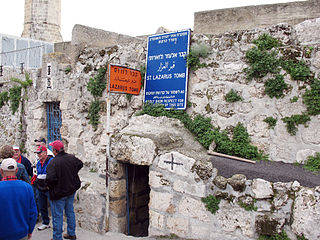Bethania │Tomb of Lazarus
Bethany is recorded in the New Testament as the home of the siblings Mary, Martha, and Lazarus, as well as that of Simon the Leper. Jesus is reported to have lodged there after his entry into Jerusalem, and it could be from Bethany that he parted from his disciples at the Ascension.
Tomb of Lazarus

The Tomb of Lazarus is a traditional spot of pilgrimage located in the West Bank town of al-Eizariya, traditionally identified as the biblical village of Bethany, on the southeast slope of the Mount of Olives, some 2.4 km (1.5 miles) east of Jerusalem. The tomb is the purported site of a miracle recorded in the Gospel of John in which Jesus raised Lazarus from the dead.
History
The site, sacred to both Christians and Muslims, has been identified as the tomb of the gospel account since at least the 4th century AD. As the Catholic Encyclopedia of 1913 states, however, while it is “quite certain that the present village formed about the traditional tomb of Lazarus, which is in a cave in the village”, the identification of this particular cave as the actual tomb of Lazarus is “merely possible; it has no strong intrinsic or extrinsic authority.” Archeologists have established that the area was used as a cemetery in the 1st century AD, with tombs of this period found “a short distance north of the church.”
Several Christian churches have existed at the site over the centuries. Since the 16th century, the site of the tomb has been occupied by the al-Uzair Mosque. The adjacent Roman Catholic Church of Saint Lazarus, built between 1952 and 1955 under the auspices of the Franciscan Order, stands upon the site of several much older ones. In 1965, a Greek Orthodox church was built just west of the tomb.
The tomb
The entrance to the tomb today is via a flight of uneven rock-cut steps from the street. As it was described in 1896, there were twenty-four steps from the then-modern street level, leading to a square chamber serving as a place of prayer, from which more steps led to a lower chamber believed to be the tomb of Lazarus. The same description applies today.
The steps enter the antechamber (3.35 m long by 2.20 m wide) through the north wall; the outline of the former entrance via the mosque can still be seen on the east wall. The floor of the antechamber is two steps above the floor level of the mosque, possibly due to rock falls from the soft limestone ceiling during construction of the Crusader-era church above the tomb. The Crusaders strengthened the tomb itself with masonry, which obscures most of the original rock surface (except for a few holes). The alignment of the tomb and antechamber suggests they predate the Byzantine churches and may very well be from the time of Jesus.
Three steps connect the antechamber with the inner burial chamber (which measures a little more than two square metres in size). It contains three funerary niches (arcosolia), now mostly hidden by the Crusader masonry. One tradition places the tomb of Lazarus to the right of the entrance, which was formerly closed by a horizontal stone. Tradition also says that Jesus was standing in this antechamber when he called Lazarus from the grave.
Source : wikipedia
https://www.youtube.com/watch?v=gkYECldS7lE
https://www.youtube.com/watch?v=RLso51foGmk
Reviews
https://goo.gl/74yFjO


Rate this article